Jamaica's Golden Jubilee
FIFTY YEARS
Love, Lust, Laughter ~ Nancy Sutton Pierce
Jamaica Hedo Nancy
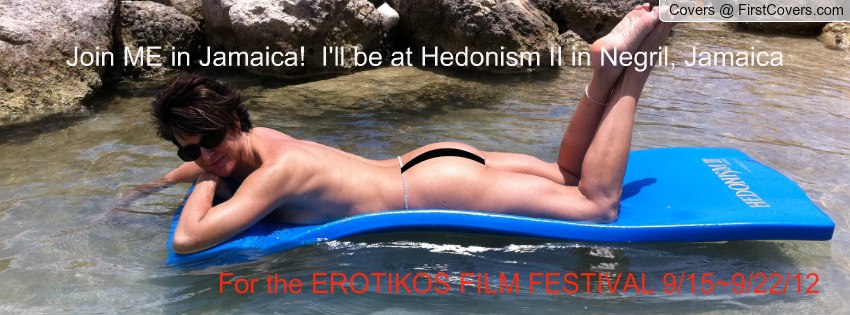
THE NUDE BEACH AT HEDONISM II. Join me!
Please take a listen (you.tube) : One Love | Playing For Change | Song Around the World
Jamaica's Golden Jubilee
FIFTY YEARS
Love, Lust, Laughter ~ Nancy Sutton Pierce
Jamaica Hedo Nancy

THE NUDE BEACH AT HEDONISM II. Join me!
Please take a listen (you.tube) : One Love | Playing For Change | Song Around the World
You Learn About the Whole World
Jamaica is a little bit of every continent. Yes, it's part new world, but part old world too. It is part "Western hemisphere" but it is very much part Africa too. It even has a touch of prim British spirit overlaying customs. Famous for pristine beaches, for Hedonism and getting your groove back. It's a playground for Europe and America, and attracts not just black cats but cougars and kittens as well. A tropical paradise from Montego Bay to the oft neglected interior. Famous for Rasta boys and Ganja, for Bob Marley and for Marcus Garvey. Did you realize how powerful the impact of Garvey has been? This eccentric Jamaican was part genius, he was a staunch proponent of the Black nationalism and Pan-Africanism movements, and for the black pride that hailed Back to Africa awareness. He was in m any ways prophetic, and a century ahead of his time, foreshadowing or inspiring future movements, ranging from the Nation of Islam to the Rastafari movement to the Africa-Unite call for setting aside the differences that divide the black people worldwide. This was a bequest of the little island of Jamaica.
But a little known heritage of Jamaica is the history of the interior, and such heroes as Cudjoe and Queen Nanny. This is the remarkable story of Jamaica's Maroons.
The Register, Thursday, August 7, 1902
THE JAMAICA MAROONS
THE HALF-FORGOTTEN STORY OF A REMARKABLE RACE WAR IN THE WEST INDIES.
John R. Speers in New York Post:
In the year 1690 a number of slaves that had been brought from the Comorantee nation in Africa fled from the hardships of plantation life in the parish of Clarendon, Jamaica, and plunging into the chaos of mountains, ridges, ravines, and crevices just back of the plantations, they found freedom and comfort. For white men could not endure the toil of man-hunting in those torrid fastnesses for any length of time. The tiny valleys though the largest of the whole region, contained but seven acres of ground in position to be cultivated. They produced an ample supply of vegetables, however, and the sheltering forests were full of wild hogs, pigeons, land crabs, and other excellent supplies of animal food. Having established themselves, these forest freemen became known as Maroons, a title taken from the Spanish word cimaron, meaning wild or unruly.For forty years the Maroons grew slowly but steadily in number, and then the loss of valuable plantation hands, together with the loss of property stolen by the Maroons, led to efforts to exterminate them. Bands of young men, accustomed to hunting, entered the mountains, and by merciless attacks on the Maroon villages, brought on a war wherein the Maroons, with savage ferocity, dealt blow for blow. For seven years this war was maintained by the runaway Negroes, who, during all that time, were able to obtain by raids ample supplies of guns and ammunition, as well as other necessaries.
A MAROON AMBUSH.
At last a day came (in 1737) when a company of white soldiers, while toiling up a steep ravine, were obliged to stop from sheer exhaustion. A moment later they heard the click of many gun locks on the mountainside above, and knowing that they had fallen into an ambush, they begged for a parley. The Negro leader, a humpbacked fellow of extraordinary ability, named Cudjoe, gave a favorable reply. Then a score or more of machetes began hacking where the gunlocks had been heard, and in a few minutes a great breadth of brush fell like a curtain from the mountainside, revealing a band of Maroons, standing with guns ready to fire on the helpless whites. It was a scene the man-hunters never forgot.
Peace followed this encounter. The treaty gave the Maroons "a perfect state of freedom and liberty," with "full pardon" for attacks on people and property. It gave them 1,500 acres of land on which to settle, and freedom to hunt for game in the mountains. Cudjoe was confirmed in his office as chief, with power to punish crimes that did not deserve death. In return for these immunities and privileges, the Maroons agreed to serve as woods policemen for the capture of runaway slaves.
Moving to their reservation, a broken stretch of land in the edge of the mountains, twenty miles south-east of Montego Bay, the Maroons built two villages, half a mile apart, called Old Town and New Town. Thereafter they were left to care for themselves – without teacher or preacher, or anyone to suggest any kind of culture or improvement. The ground, with gentle coaxing, produced crops, which not only supplied them with ample food, but left a surplus sufficient to procure, by exchange, such clothing and other manufactured supplies as their simple life demanded. There was no incentive to give them habits of industry; on the contrary, because rum was easily obtained, there was a constant inducement to drink to excess, an inducement that was the stronger because many white planters drank immoderately. Moreover, they were often employed in the work of bloodhounds, in trailing fugitive slaves through the mountains. The whole-atmosphere of Maroon life was loaded with the fungus spores of degeneration.
But the Maroons did not degenerate. A free mountain life saved them. They purchased leaf tobacco and manufactured a salable twist. They cured meats for which they found a ready market. They accumulated coin. Evidences of financial prosperity steadily, if slowly, increased among them.
They grew in mind also. The mountain passes into which the Maroons plunged whenever they left their home were so crooked and intricate that a long-range system of communication was a chief need of their manner of life. They therefore made a kind of bugle of a cow horn, the sounds of which rang through the ravines with startling effect. Then, finding a mere blast of the horn insufficient for their needs, they developed a telegraphic code in which every individual in the village had his own peculiar call, and by which communications on important matters were readily held.
A REMARKABLE RACE WAR.
A capable white official who had lived among them as an agent for planters who wished for Maroons to hunt runaway slaves was removed. His successor excited the contempt, and finally the anger, of the Maroons, and they drove him away – an act of rebellion against the Government! Then two Maroons, who were wandering about a white settlement, were accused of killing tame hogs; they were quickly tried and convicted, and were publicly whipped. A slave whom they had captured when he was a runaway in the mountains applied the lash – with vigor, as may be supposed. The sentence was executed, too, before a jeering throng of slaves. The whole plantation of the Maroon reservation became wildly excited, and some got drunk and sent threatening messages to the whites, while others appeared under arms on the heights overlooking the plantations.
At this time (July, 1795) the total Maroon population of the island was 1,400. That of the two villages in so called revolt was not far from 500. The white population of the island was 30,000. There were 2,000 regular troops stationed on the island, besides 7,000 men enrolled in the militia. And yet the story of the appearance of a handful of drunken Maroons, with arms in hand, on the mountainside, spread panic around the island. The militia were all called out, and royal troops that had embarked on an expedition against the French were brought back by a swift schooner.
But before an attack was made on the Maroon reservation, a number of white men went up to see if trouble could not be averted by negotiation. These succeeded so well that the Maroons deputed six of their leading men to go down and apologize for the deeds of the young drunkards. But the panic among the white people was so great that the authorities refused to ratify the agreement of the peace makers, and the six representatives of a penitent tribe were ironed and put in prison.
A worse act of bad faith followed. TheGovernor, Lord Balcarres, issued a proclamation on August 8, 1795, saying that all Maroons submitting themselves on or before the 12th should be pardoned, while all who failed to do so were declared outlaws, to be killed on sight. This proclamation received due consideration from the Maroons, because two of their leading men named Johnson and Smith, used their influence in favor of peace. Accordingly, on the 11th, thirty-seven Maroons, including two captains, named James Palmer and Edward Parkinson, surrendered themselves. But instead of receiving kind treatment, they were first thrown into prison, and then sent on board a ship lying in Montego Bay.
That was in the days when the slave trade was yet lawful. These men supposed they were to be sold as slaves and as they reached the deck, one of them, a black, Patrick Henry, drew a knife he had concealed, and killed himself by ripping open his abdomen.
This treachery ended all hope of a peaceful adjustment of the difficulty, but the whites tried once more to induce the Maroons t surrender. Two of the thirty-seven who had been imprisoned on the ship were released, and sent to the reservation with a message from the Governor; but as they climbed the gorges they sounded on their horns the signals by which they were known. And as these signals froze every one on the reserve in to an attitude of eager attention, they announced with clarion blasts that all who had submitted with them had been sent on a ship to be sold into slavery.
TREACHERY OF THE WHITES.
With 104 bloodhounds to support them, the Government forces advanced into the ravines and offered peace, an offer that was accepted when the commanding officer (Gen. Walpole) promised the Maroons an oath that they should not be sent from the island.
But because their nerves were yet quivering with fear the whites once more broke faith. They sent the Maroons to Nova Scotia.
Before following the career of the Maroons any further, we will now recall the work of that notable old time abolitionist, Granville Sharp. He had been trained by Quakers, and had formulated this striking rule of life:
"Right ought to be adopted and maintained on all occasions, without regard to consequences, either probable or possible." It led him to befriend the vagrant slave James Somerset, with results that all remember well, and it made him a friend of the race, not in spite of their inferiority, but because as a race they were less developed than the whites, and therefore needed help.
To provide for 400 and odd Negro sailors who had been discharged from the British navy, Sharp entered into a movement through which the Negroes with sixty white instructors and helpers sailed (April 8, 1787) to establish a settlement where now the colony of Sierra Leone is found.
But the black sailors made bad colonists. Rum and the coast fever carried off half of them. To the remnant came a company of 1,131 Virginia Negroes – slaves who had been carried off by the British during the war of the Revolution – but these proved no better than the sailors. They were lacking in the qualities needed in men who would make homes in the wilderness, and at the end of September, 1800, a mutiny among those who had survived the fever reached such portentous proportions that all hope of maintaining a civilized settlement on the coast was abandoned. The whites were preparing to flee to Europe, and leave the Negroes to join the barbarous tribes in the neighborhood, when a ship sailed into the harbor unannounced. And when all was made snug, it landed 550 of the Maroons that had been exiled from Jamaica to Halifax Bay.
By their martial prowess the Maroons had baffled the people of Jamaica. By stubbornly refusing to work in a cold climate they had baffled the people of Nova Scotia. But when migration to Sierra Leone was offered them, they accepted it willingly.
Having been uncrushed in their island home, and in their frigid exile, they landed in Africa with masterful feeling and bearing. They dominated the disintegrating settlement. They drove out mutiny, filled the despairing with hope and in their own way transformed Sierra Leone from the condition of a poorfarm and orphan asylum into a self respecting colony of a great empire.
Also see: Those stubborn Maroons
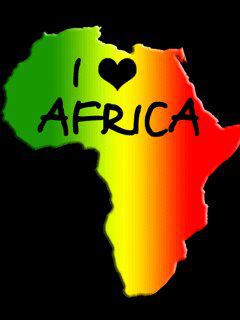
♥
One
gg
Love
Rich white women find BBC in Jamaica rent-a-rasta - Sex tourism in Jamaica is huge and a much larger part of the tourist industry in this country than many want to admit to. (Hedo resorts, Nude beaches, Mandingo lover-boys.)Tropical ToXic - white women travel thousands of miles to mix business and pleasure : Jamaica's sex tourism, hedonism and white customers getting their groove back
Jamaica Gleaner : The Road To Freedom - Jamaica's first emancipation day - a day of religion and revelry, joy and thankfulness
Back to Africa found "Ethiopia" - one aspect of the Black Pride movement was the discovery of a glorious homeland (Afro-centrism), and Ras Tafari ... the germinal Ethiopian contribution.
Did sacred scripture originate in Africa? - not for nothing is the Nile called the Mother of Civilization. But look a little deeper and the Great Rift Valley had a seminal role. (Biblical origins)
Africa Unite : gather together in my Name - why do all the great Shemitic based religious have spiritual connections to this Mother continent of the human race?
African Triumph - Mother of the Human Race - the darkest continent has shed the most light. Progenitor of world monotheism, source of our shemitic conception of the deity. AFRICA.
When pampered Americans set a bad example - pastors raise their voice against the West's slide into promiscuity and a carnal way of life (decadence)
Cougar prowl - sex tourism in the Islands - beach boys and gringueros, rent-a-dreads, rent-a-rastas, rent-a-gents, sanky-panky and "big bamboo" -- "women go to Ja and pay to get good wood. . . . and sometimes fall in love"
Jamaica's R&R for white women - not rest and relaxation but RENT A RASTA. Those black guys are the "hottest" lovers a woman can find. A blessing may be a curse .... how can she ever go back?
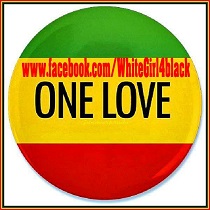
| Susan Crain Bakos writes: "The woman who goes after black men is a variant of sex journalist Susie Bright’s “white bitch in heat,” a woman who puts sex first even though women aren’t supposed to do that. According to one school of thought, white women turn to black men when their sex drives kick into higher gear and their social inhibitions recede into the rearview mirror. It’s a “yes, baby, now I’m ready for you” reaction." |
| When white women flock to Jamaica for a little fun in the sun, the R&R they're often looking for is not "Rest and Relaxation" but to "Rent a Rasta" according to director J. Michael Seyfert. His eye-opening expose' of the same name sheds light on a barely acknowledged form of sex tourism, namely, white women who visit the Caribbean Islands to get their groove back with the help of black locals. Focusing on Rastafarian culture this documentary claims that, each year, as many as 80,000 females from a variety of relatively-wealthy Western nations descend on Jamaica alone. |
Rob Watton is an encourager (like me)
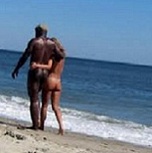

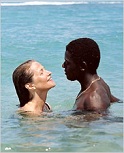
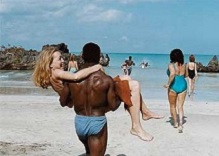
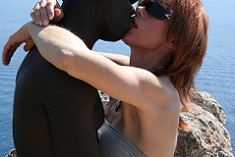
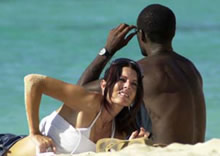
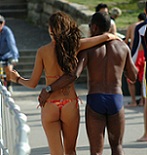
The hope is that one day Black Men in America will no longer be viewed as
unintelligent, unattractive, undesirable, uncivilized & just plain old worthless.
One Race ~ the Human Race
________
LAST SAVE = 8/31/2014